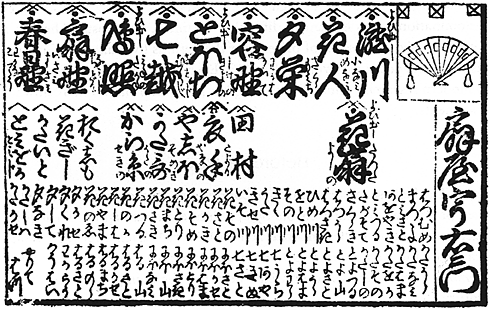 |
|
|
|
A saiken was a directory of courtesans and prostitutes published twice a year, in spring (First Month) and in fall (Seventh Month), from the late 17th century to 1872. This page is a guide to the Ôgiya, marked by its fan symbol. The class of each women working there is identified by the position and print size of her name on the chart, a classification symbol (or lack of one) above her name, and sometimes a gloss to the right of her name. Here we see that in fall 1787, Takigawa, whose name is next to the Ôgiya's symbol, was the house's top courtesan as a yobidashi. The yobidashi set off on the second row is the famous Hanaogi, who was making her debut that year and thus was specially featured. After 1761, the previous top designations of tayû and kôshi were generally replaced by yobidashi (or yobidashi chûsan, price = 3 bu or about $150-$350 per day or night), chûsan (3 bu), and tsukemawashi (2 bu), which were initially the top classes referred to generically as oiran. Below these classes and in the center of the second row were zashikimochi (1-2 bu), which were later also called oiran. To the left of them are the heyamochi (0.5-1 bu) and below are shinzô, attendants to the higher ranks who also usually took customers at a less expensive rate. The major houses did not have ranks lower than shinzô while the small houses had neither these higher ranks nor shinzô, only prostitutes known under less standardized terms such as kiri (short-time), kashi (moatside), and teppô (gun). |
|
|